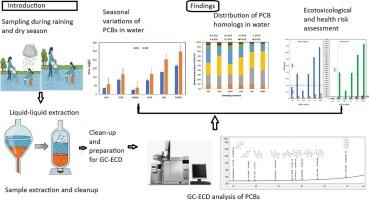尼日利亚西南部河流中的多氯联苯:来源、季节性分布和人类健康风险评估
IF 8
1区 环境科学与生态学
Q1 ENVIRONMENTAL SCIENCES
引用次数: 0
摘要
本研究调查了尼日利亚西南部六条主要河流中多氯联苯(PCB)的污染情况。采用高分辨率气相色谱联用电子捕获检测器(GC-ECD)对25种PCB化合物进行了测定。旱季总PCB(∑PCB)浓度为21.92 ~ 186.17 ng/L,雨季为35.22 ~ 262.32 ng/L。各地点和季节共面多氯联苯的平均浓度在12.84 ~ 97.41 ng/L之间。低卤化多氯联苯占主导地位,占总数的61.2%,且同系物分布一致。三维主成分分析(PCA)表明,河流中的多氯联苯来源相似。∑PCB浓度超过USEPA标准(14 ng/L),对水生生物和人类健康构成威胁,需要进一步调查。毒性当量浓度(TEQ)范围为0.165 ~ 1.826,其中PCB 126为主要驱动因子,毒性最强。儿童和成人摄入的估计危害指数(HI)值在9.97 × 10−5至1.50 × 10−2之间,而皮肤暴露值在9.17 × 10−6至6.74 × 10−4之间。然而,在两个年龄组中,饮水引起的癌症风险(CR)显著(>10−6),皮肤暴露引起的CR相当大(10−6 <;CR & lt;10−4)成人专用。TEQ、HI和CR水平表明,尼日利亚河流中的多氯联苯污染构成重大健康风险。本文章由计算机程序翻译,如有差异,请以英文原文为准。

Polychlorinated biphenyls (PCBs) in rivers of Southwestern Nigeria: sources, seasonal distribution, and assessment of human health risks
This study investigated the pollution of polychlorinated diphenyl (PCB) in six major rivers in Southwest Nigeria. Twenty-five PCB compounds were determined using high-resolution gas chromatography coupled with an electron capture detector (GC-ECD). Total PCB (∑PCBs) concentrations varied from 21.92 to 186.17 ng/L during the dry season and 35.22 to 262.32 ng/L during the wet season. Mean concentrations of coplanar PCBs were between 12.84 and 97.41 ng/L across all locations and seasons. Low halogenated PCBs are dominant, accounting for 61.2 % of the total, and show a consistent distribution of homologs. A 3-dimensional principal component analysis (PCA) indicated that most PCBs in the rivers come from similar sources. The ∑PCB concentrations exceeded the USEPA standard of 14 ng/L, posing risks to aquatic life and human health and necessitating further investigation. The Toxic Equivalent Concentration (TEQ) ranged from 0.165 to 1.826, with PCB 126 as the main driver with the highest toxic potency. The estimated hazard index (HI) values for ingestion were between 9.97 × 10−5 and 1.50 × 10−2 for both children and adults, while dermal exposure values ranged from 9.17 × 10−6 to 6.74 × 10−4. However, cancer risk (CR) from water consumption was significant (>10−6) for both age groups, and CR from dermal exposure was substantial (10−6 < CR < 10−4) only for adults. The TEQ, HI, and CR levels indicate that PCB contamination in Nigerian rivers poses significant health risks.
求助全文
通过发布文献求助,成功后即可免费获取论文全文。
去求助
来源期刊

Science of the Total Environment
环境科学-环境科学
CiteScore
17.60
自引率
10.20%
发文量
8726
审稿时长
2.4 months
期刊介绍:
The Science of the Total Environment is an international journal dedicated to scientific research on the environment and its interaction with humanity. It covers a wide range of disciplines and seeks to publish innovative, hypothesis-driven, and impactful research that explores the entire environment, including the atmosphere, lithosphere, hydrosphere, biosphere, and anthroposphere.
The journal's updated Aims & Scope emphasizes the importance of interdisciplinary environmental research with broad impact. Priority is given to studies that advance fundamental understanding and explore the interconnectedness of multiple environmental spheres. Field studies are preferred, while laboratory experiments must demonstrate significant methodological advancements or mechanistic insights with direct relevance to the environment.
 求助内容:
求助内容: 应助结果提醒方式:
应助结果提醒方式:


